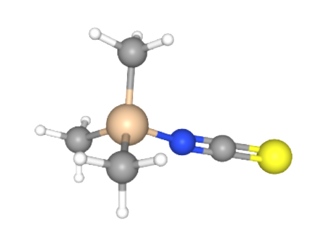
RDX (abbreviation of "Research Department eXplosive") or hexogen, among other names, is an organic compound with the formula (O2N2CH2)3. It is white, odorless and tasteless, widely used as an explosive. Chemically, it is classified as a nitroamine alongside HMX, which is a more energetic explosive than TNT. It was used widely in World War II and remains common in military applications.

An explosive is a reactive substance that contains a great amount of potential energy that can produce an explosion if released suddenly, usually accompanied by the production of light, heat, sound, and pressure. An explosive charge is a measured quantity of explosive material, which may either be composed solely of one ingredient or be a mixture containing at least two substances.

Trinitrotoluene, more commonly known as TNT, more specifically 2,4,6-trinitrotoluene, and by its preferred IUPAC name 2-methyl-1,3,5-trinitrobenzene, is a chemical compound with the formula C6H2(NO2)3CH3. TNT is occasionally used as a reagent in chemical synthesis, but it is best known as an explosive material with convenient handling properties. The explosive yield of TNT is considered to be the standard comparative convention of bombs and asteroid impacts. In chemistry, TNT is used to generate charge transfer salts.

Pentaerythritol tetranitrate (PETN), also known as PENT, pentyl, PENTA, TEN, corpent, or penthrite, is an explosive material. It is the nitrate ester of pentaerythritol, and is structurally very similar to nitroglycerin. Penta refers to the five carbon atoms of the neopentane skeleton. PETN is a very powerful explosive material with a relative effectiveness factor of 1.66. When mixed with a plasticizer, PETN forms a plastic explosive. Along with RDX it is the main ingredient of Semtex and C4.

Ammonium nitrate is a chemical compound with the chemical formula NH4NO3. It is a white crystalline salt consisting of ions of ammonium and nitrate. It is highly soluble in water and hygroscopic as a solid, although it does not form hydrates. It is predominantly used in agriculture as a high-nitrogen fertilizer.
Polymer-bonded explosives, also called PBX or plastic-bonded explosives, are explosive materials in which explosive powder is bound together in a matrix using small quantities of a synthetic polymer. PBXs are normally used for explosive materials that are not easily melted into a casting, or are otherwise difficult to form.

A plasticizer is a substance that is added to a material to make it softer and more flexible, to increase its plasticity, to decrease its viscosity, and/or to decrease friction during its handling in manufacture.

Smokeless powder, also referred to as gunpowder, is a type of propellant used in firearms and artillery that produces less smoke and less fouling when fired compared to black powder. The combustion products are mainly gaseous, compared to around 55% solid products for black powder. In addition, smokeless powder does not leave the thick, heavy fouling of hygroscopic material associated with black powder that causes rusting of the barrel.
The Composition C family is a family of related US-specified plastic explosives consisting primarily of RDX. All can be moulded by hand for use in demolition work and packed by hand into shaped charge devices. Variants have different proportions and plasticisers and include composition C-2, composition C-3, and composition C-4.

TATB, triaminotrinitrobenzene or 2,4,6-triamino-1,3,5-trinitrobenzene is an aromatic explosive, based on the basic six-carbon benzene ring structure with three nitro functional groups (NO2) and three amine (NH2) groups attached, alternating around the ring.
This is a compilation of published detonation velocities for various high explosive compounds. Detonation velocity is the speed with which the detonation shock wave travels through the explosive. It is a key, directly measurable indicator of explosive performance, but depends on density which must always be specified, and may be too low if the test charge diameter is not large enough. Especially for little studied explosives there may be divergent published values due to charge diameter issues. In liquid explosives, like nitroglycerin, there may be two detonation velocities, one much higher than the other. The detonation velocity values presented here are typically for the highest practical density which maximizes achievable detonation velocity.

Ethylene glycol dinitrate, abbreviated EGDN and NGC, also known as Nitroglycol, is a colorless, oily, explosive liquid obtained by nitrating ethylene glycol. It is similar to nitroglycerine in both manufacture and properties, though it is more volatile and less viscous. Unlike nitroglycerine, the chemical has a perfect oxygen balance, meaning that its ideal exothermic decomposition would completely convert it to low energy carbon dioxide, water, and nitrogen gas, with no excess unreacted substances, without needing to react with anything else.
According to researcher Chuck Hansen, the W34 Python was a gas-boosted fission primary used in several designs of American thermonuclear weapons.
Oxygen balance is an expression that is used to indicate the degree to which an explosive can be oxidized, to determine if an explosive molecule contains enough oxygen to fully oxidize the other atoms in the explosive. For example, fully oxidized carbon forms carbon dioxide, hydrogen forms water, sulfur forms sulfur dioxide, and metals form metal oxides. A molecule is said to have a positive oxygen balance if it contains more oxygen than is needed and a negative oxygen balance if it contains less oxygen than is needed.

Erythritol tetranitrate (ETN) is an explosive compound chemically similar to PETN, though it is thought to be slightly more sensitive to friction and impact.

G2ZT is a bistetrazole. It is an explosive approximately as powerful as RDX, but it releases less toxic reaction products when detonated: ammonia and hydrogen cyanide. When combined with ADN or AN oxidizers, the amount of HCN produced by a deflagration may be reduced. The compound is thus considered by its advocates to be an environmentally friendlier explosive than traditional nitroamine-based explosives.

Oxadiazoles are a class of heterocyclic aromatic chemical compound of the azole family; with the molecular formula C2H2N2O. There are four isomers of oxadiazole:

Dinitromethane is an organic compound with the chemical formula CH2(NO2)2. Purified dinitromethane is a colorless liquid with a weak pleasant odor. It is relatively stable at room temperature and can be safely stored for months at 0 °C.

Trimethylsilyl isothiocyanate (TMSNCS) is an organosilicon compound that contains an isothiocyanate whose nitrogen atom is covalently bonded to a trimethylsilyl group. The isothiocyanate group is an analog of the isocyanate group, but having a sulfur instead of oxygen.
Guanylurea dinitramide is a novel insensitive high explosive.














